Seven questions about LED lamps
Five years ago, LED lamps were a technical novelty, today LED lamps are sold in every household goods store, in five years the vast majority of apartments will most likely be lit with LED lamps.
In this article I will try to answer the questions that most often arise for those who first encounter LED lamps.
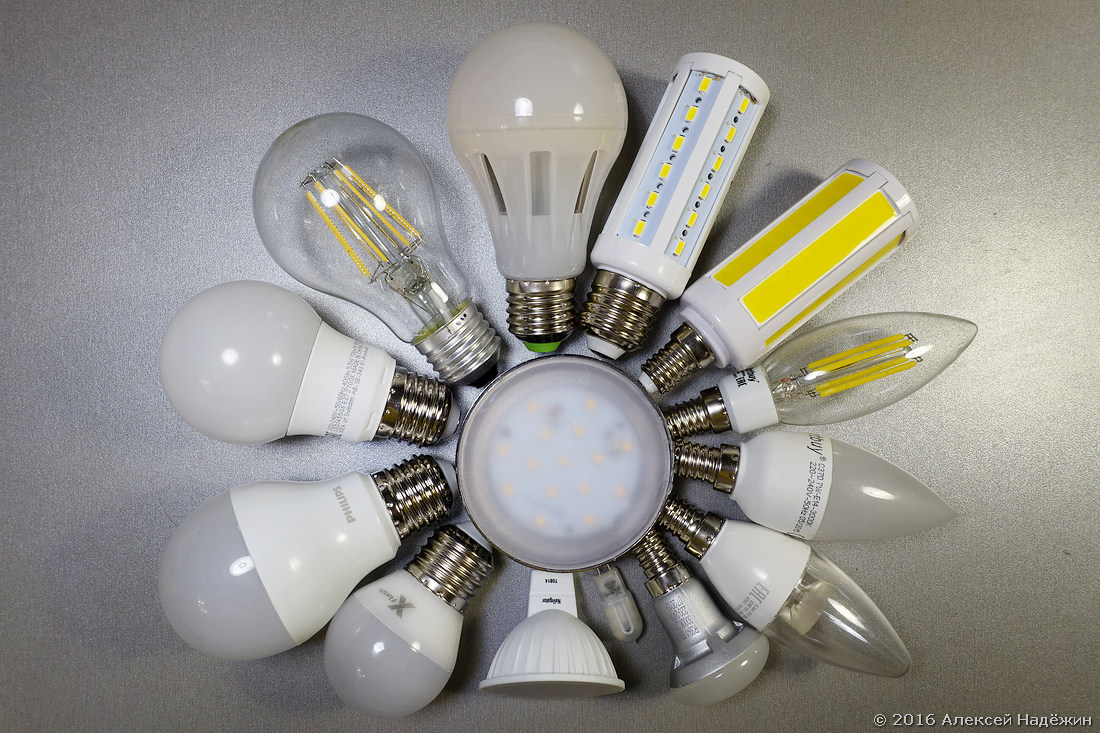
Conventional bulbs shine well, but are very energy inefficient - 95% of their energy is converted into heat. Funny fact: after the ban on the sale of bulbs, more powerful than 100 watts, manufacturers, as if nothing had happened, continue to produce them, but they are called not light bulbs, but “heat emitters” and in fact they are right.
Modern LED lamps consume 8-10 times less energy than incandescent lamps with the same luminous flux, which means that when lighting with LED lamps, it will be possible to pay 8-10 times less for lighting.
I made a calculation of the cost of lighting a two-room apartment with conventional and LED lamps.
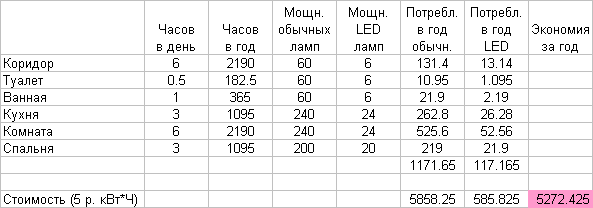
Of course, the calculation is very approximate. Nevertheless, 3-5 thousand rubles a year is a very real saving for an average apartment. Pay attention to the burning time of the lamps. Manufacturers promise 1000 hours of operation of the incandescent lamp (in reality, the bulbs often burn out much earlier), but even if the lamps work for 1000 hours, they will have to be changed in the corridor and room twice a year, and in the kitchen and bedroom once. With an average cost of a lamp of 30 rubles, it will take another 690 rubles.
LED lamps do not have to be replaced every six months. Manufacturers promise 25-50 thousand hours of work. This is more than 11-22 years with daily use of 6 hours.
A set of LED lamps for this average apartment will cost 4380 rubles (7 E27 6W lamps for 280 rubles, 11 4W candles for 220 rubles) and they will pay off in less than a year.
Good LED lamps give the same comfortable light as incandescent lamps and you cannot distinguish their light from incandescent light.
A 60-watt incandescent lamp, when the voltage is reduced to 207 V, starts to shine like a 40-watt lamp, and if the voltage drops to 180 volts (which often happens in rural areas), a 60-watt lamp "turns" into a 25-watt one. The LED lamp shines with the same brightness at any voltage and is not afraid of power surges.
Unlike incandescent lamps, LED lamps have a slight heat. Lamps do not heat the room when it is already hot in it. The child will not burn on the light bulb in the table lamp.
And LED bulbs give freedom and comfort. No more worries about saving electricity: when the bulb consumes 6 watts rather than 60, you can simply not turn it off. Previously, I always turned off the light in the corridor, now it always burns when I'm at home. So convenient.
And one more, last argument in favor of buying LED lamps. Do not treat them as consumables. You buy them for a long time. Treat them the same way as the chandelier or lamp in which you install them, because most likely someday you will replace them together, because the LED lamps will not burn out.
Of course, LED lamps can be considered energy-saving, however, in Russian the word "energy-saving" is attached to compact fluorescent lamps (CFLs), and CFLs and LED lamps are completely different things.
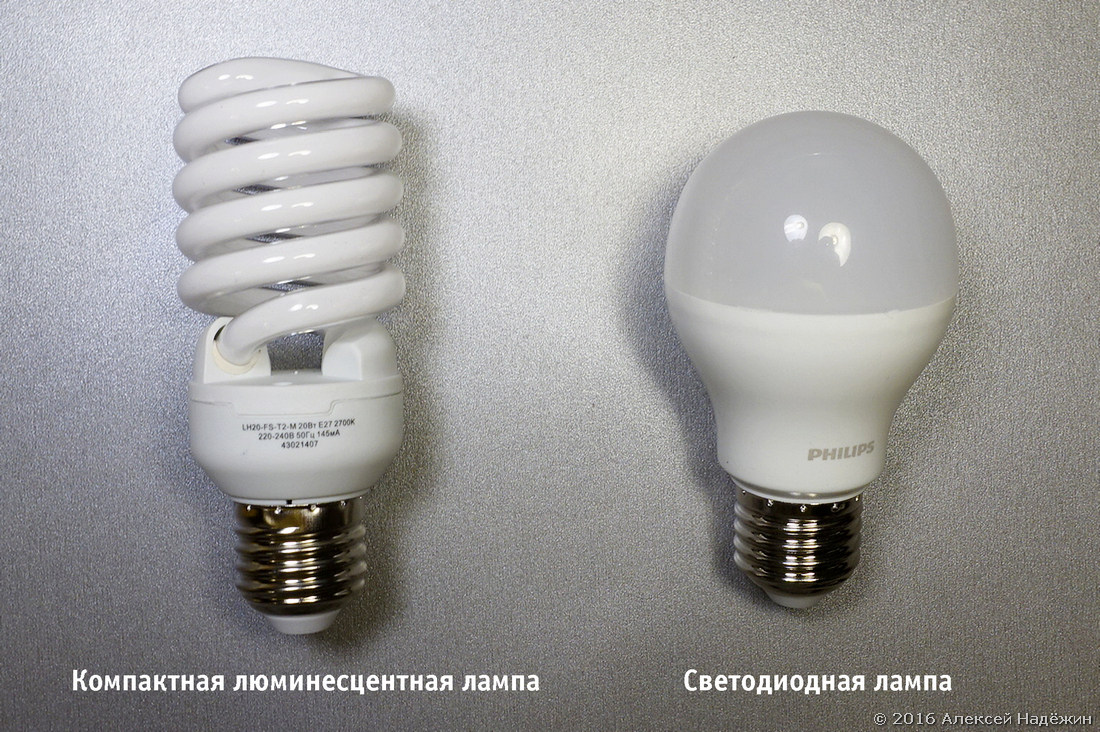
LED lamps are much better than CFLs for several reasons:
• LED lamps do not contain hazardous substances, and any CFL bulb contains mercury;
• LED lamp consumes less energy with the same luminous flux;
• LED lamp instantly lights up to full brightness, and CFL gradually gains brightness from 20% to 100% per minute at room temperature and much slower at low temperatures;
• CFL has a poor spectrum consisting of peaks of several colors. The range of LED lamps is much closer to natural light and incandescent light.
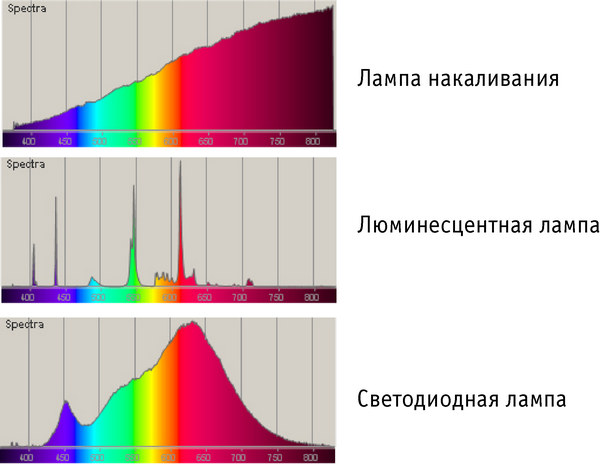
In 1923, the Soviet physicist Oleg Losev discovered the electroluminescence of a semiconductor junction. The first LEDs using this principle were called “Losev Light” (Losev's light). The first red LED appeared, then in the early 70s there were yellow and green LEDs. The blue LED was created in 1971 by Yakov Panchechnikov, but it was extremely expensive. In 1990, the Japanese Suji Nakamura created a cheap and bright blue LED.

20 years ago it was believed that it was impossible to create a white LED, however, after the appearance of the blue LED, it became possible to make white light sources with three crystals (RGB).
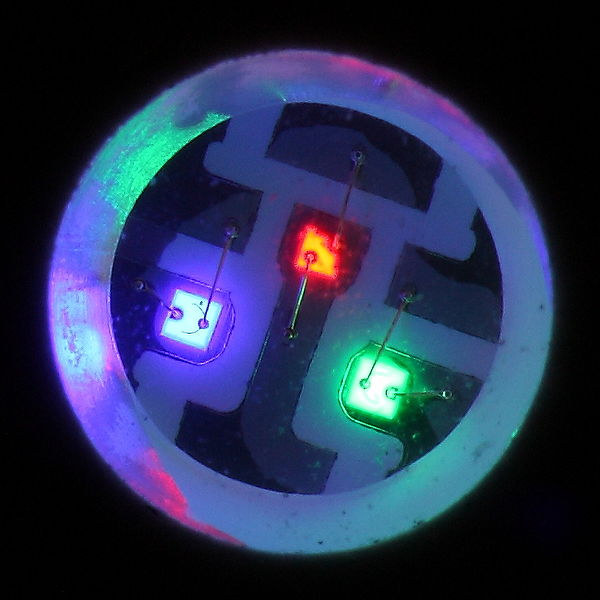
In 1996, the first white phosphor LEDs appeared. In them, the light of an ultraviolet or blue LED is converted to white using a phosphor.
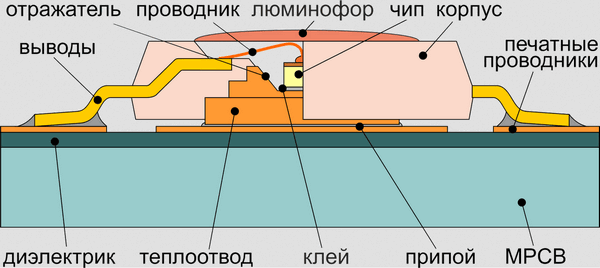
By 2005, the light efficiency of such LEDs reached 100 lm / W or more. This allowed us to start using phosphor LEDs for lighting, because the LED is one of the most economical light sources.
LED lamps are available in various housings with different types of socles. These are ordinary “pears”, “candles” and “balls” with E27 and E14 sockets, and “mirror” lamps R39, R50, R63 and spotlights with GU10 and GU5.3 sockets, capsule lamps with G4 and G9 sockets, lamps for ceilings with base GX53.
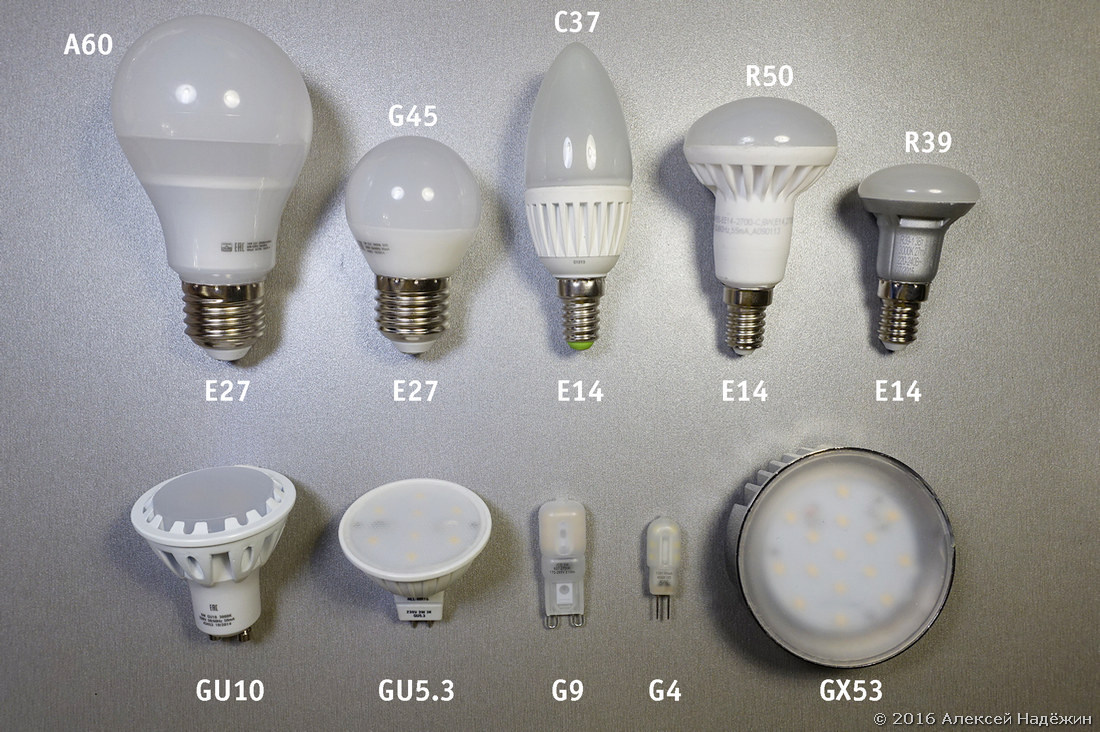
LED lamps use various types of LEDs. The first LED lamps used conventional LEDs in a plastic case.
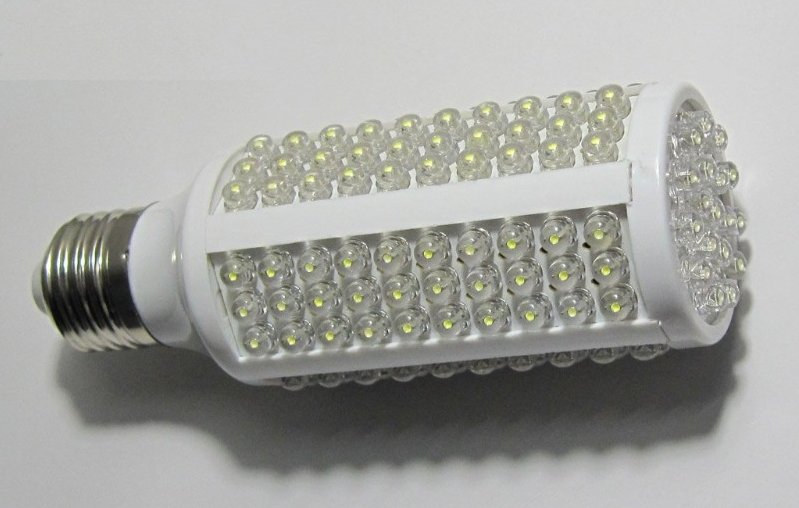
Now, powerful LEDs in cases are used only in some lamps.
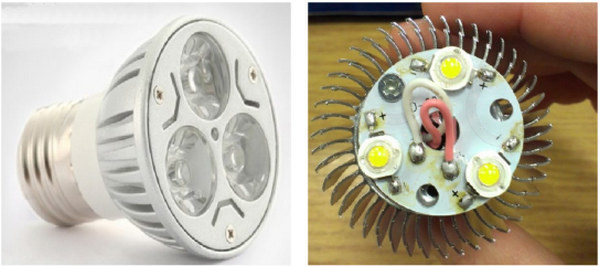
Most modern bulbs use frameless LEDs and LED assemblies.
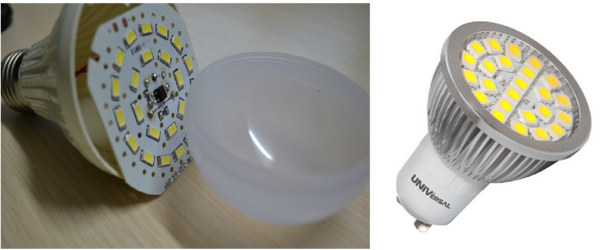
Recently, COB (chip on board) LED emitters have been increasingly used. They have many LEDs coated with a single phosphor.
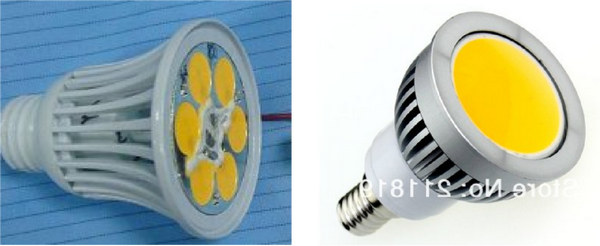
A variation of COB is LED filament. They have many LEDs placed on a glass strip coated with a phosphor.
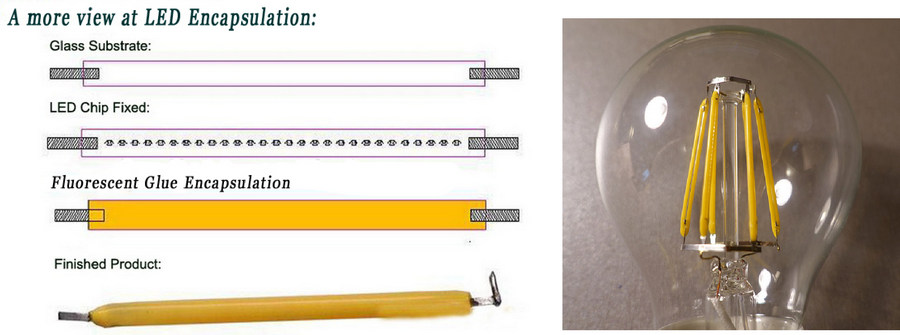
In the latest generation of Crystal Ceramic MCOB lamps, the emitters are mounted on round transparent ceramic plates.
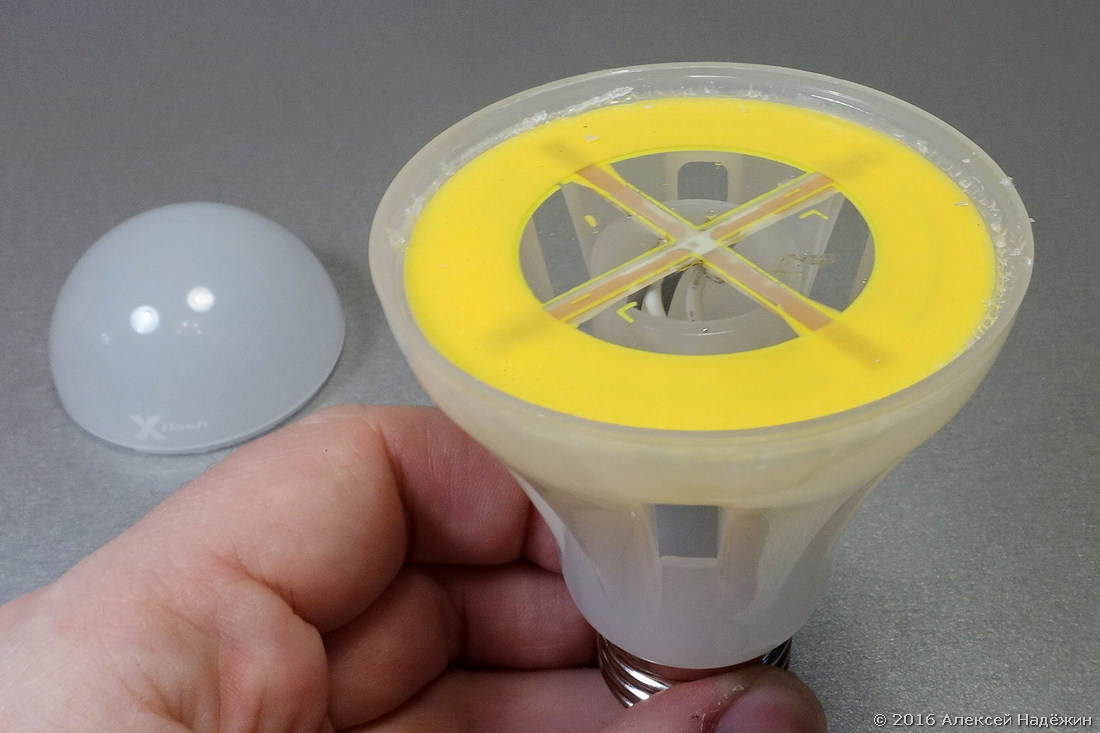
LED lamps are available with different color light temperatures: 2700K - yellow light, like incandescent lamps, 3000K - slightly more comfortable white light, 4000K - white light, 6500K - cold white light. In my opinion, lamps with a color temperature of 2700-3000K are more suitable for a home.
No not always. There are two problems that you may encounter:
• Working with a switch that has an indicator. A large number of LED lamps cannot work with switches that have an indicator. They flash or light when the switch is turned off. This is due to the fact that a weak current constantly flows through the lamp. There are two ways out of this situation: either use lamps that work correctly with such switches or turn off the indicator inside the switch.
• Dimming. Most LED lamps cannot work with dimmers (dimmers), but there are special dimmable LED lamps (as a rule, they are much more expensive than usual). Unlike incandescent lamps, when the brightness is reduced, the LED lamp does not change the color of lighting (in a conventional lamp it turns yellow). Many dimmable LED lamps are not dimmed to zero, but only to 15-20% of full brightness.
In ordinary incandescent lamps, everything is simple: a bulb and a tungsten filament. The LED lamp is much more complex and its quality depends on the quality of LEDs, phosphor and electronics.
There are three important parameters that affect the quality of light that a lamp gives:
• Ripple of light. Many low-quality lamps have a high level of pulsation (flicker) of light. Such a light is visually uncomfortable and a person quickly gets tired of it. When looking from one object to another, a stroboscopic effect is visible (as if several objects are visible instead of one). The human eye perceives a pulsation of more than 40%. There are two ways to check for light pulsation - pencil test(we take an ordinary long pencil by the tip and begin to quickly and quickly move it in a semicircle there and back. If there are no individual contours of the pencil, there is no flickering, if “several pencils” are visible, the light is flickering) and checking with the smartphone’s camera (if look at the light through the smartphone’s camera, as a rule, when the light flickers, streaks will go across the screen, and the brighter they are, the stronger the flicker). Lamps with visible pulsation cannot be used in residential premises.
• Color rendering index (CRI). The light spectrum of an LED lamp differs from the spectrum of sunlight and light from a conventional incandescent lamp. Although the light looks white, some of the color components in it are more, and some less. CRI shows how uniform the level of different color components in the light. At low CRI, shades are less visible. Such a light is visually unpleasant, and it’s very difficult to understand what’s wrong in it. Incandescent and solar lamps have CRI = 100, ordinary LED lamps have more than 80, very good have more than 90. Lamps with CRI below 80 in residential premises should not be used.
• Lighting angle. LED lamps of the “pear” type come in two forms. In the former, the protective cap has the shape of a hemisphere having the same diameter as the body. Such lamps do not shine back at all, and if they shine down in the chandelier, the ceiling will remain dark, which can be visually ugly. In the second type of lamp, the transparent cap has a diameter larger than the body and the lamp shines a little back. Lamps on LED filaments or transparent discs have the same wide angle of illumination as conventional incandescent lamps.
Halogen spotlights give a narrow beam of light with an angle of illumination of about 30 degrees, and most LED spotlights shine with diffused light with an angle of about 100 degrees. Such light bulbs in the false ceiling "blind" because of the too wide angle. Only some LED spotlights have lenses and the same narrow lighting angle as halogen lamps.
And three more problems that you can often encounter with LED lamps:
• Inconsistency of the luminous flux and equivalent to the declared values. Unfortunately, often on the packaging of LED lamps write high values of luminous flux and equivalent. You can find lamps on which a luminous flux of 600 Lm is indicated and the fact that the lamp replaces a 60-watt incandescent lamp, and in fact it shines only like a 40-watt lamp.
• Mismatch in color temperature declared. Very often there are lamps whose color temperature of light differs from what the manufacturer promises. Instead of 2700K, you can find 3100K, and instead of 6000K, even 7200K.
• Premature lamp failure. Manufacturers indicate the life of LED lamps from 15,000 to 50,000 hours, in fact the lamps sometimes break after several months of operation.
Lamps from several dozen brands are represented on the Russian market. Most of them are Russian brands that manufacture custom-made lamps in China. Many people think that since the lamps are Chinese, it is better and cheaper to buy them in Chinese online stores, but this is a big mistake. Unfortunately, the vast majority of lamps from Chinese stores are of very poor quality. Their power and luminous flux are much lower than promised, the color rendering index (CRI) is low, many lamps have ripple, sometimes reaching up to 100%, the color temperature does not normalize (the Chinese often write “warm white light 2700-3500K” and what will happen in fact no one knows), there is no guarantee for such lamps and in case of failure to change them will not work. I tested dozens of lamps from Chinese online stores and there was only one good one,
I know only four brands that do not overestimate the luminous flux and equivalent on the package. These are Ikea, Osram, Philips and Diall, so when buying lamps of all other brands, it is better to take lamps "with a margin". If you need to replace a 40-watt light bulb, it is better to take the one that says "60 W incandescent lamp equivalent."
If you have the opportunity to turn on the lamp when buying, make sure that it does not flicker with a pencil test or smartphone. Lamps with unacceptable ripple come across even with brands such as Osram.
If flickering is found already at home, feel free to return the lamp - according to Russian laws, LED lamps can be returned to the store within 14 days from the date of purchase.
Pay attention to the warranty period (the warranty for lamps can be from one to five years) and keep the checks. Lamps must be exchanged at the point of purchase.
About what LED lamps of different models are, what they give the real luminous flux, what incandescent lamps they can fully replace, what kind of CRI, color temperature and level of ripple, whether they can work correctly with switches that have an indicator, I write on the blog of his Lamptest project at Geektimes . I regularly test LED bulbs and post the results. Now tested more than 400 lamp models.
Regarding " M. Video”, The LED lamps appeared there only recently and really want to hope that in the near future their range in the network stores will expand.
For more than a year in my apartment there are no other sources of light except LED. This gives good electricity savings, allows you to forget about the frequent replacement of lamps and gives additional freedom - for example, I often do not turn off the lights in the corridor, because the lamp consumes only 7 watts.
I hope that LED lighting will appear in your home soon. But before that, we will make one interesting post from one of the industries with which M.Video works.
© 2016, Alexey Nadezhin specially for
In this article I will try to answer the questions that most often arise for those who first encounter LED lamps.

1. Why buy LED bulbs?
Conventional bulbs shine well, but are very energy inefficient - 95% of their energy is converted into heat. Funny fact: after the ban on the sale of bulbs, more powerful than 100 watts, manufacturers, as if nothing had happened, continue to produce them, but they are called not light bulbs, but “heat emitters” and in fact they are right.
Modern LED lamps consume 8-10 times less energy than incandescent lamps with the same luminous flux, which means that when lighting with LED lamps, it will be possible to pay 8-10 times less for lighting.
I made a calculation of the cost of lighting a two-room apartment with conventional and LED lamps.

Of course, the calculation is very approximate. Nevertheless, 3-5 thousand rubles a year is a very real saving for an average apartment. Pay attention to the burning time of the lamps. Manufacturers promise 1000 hours of operation of the incandescent lamp (in reality, the bulbs often burn out much earlier), but even if the lamps work for 1000 hours, they will have to be changed in the corridor and room twice a year, and in the kitchen and bedroom once. With an average cost of a lamp of 30 rubles, it will take another 690 rubles.
LED lamps do not have to be replaced every six months. Manufacturers promise 25-50 thousand hours of work. This is more than 11-22 years with daily use of 6 hours.
A set of LED lamps for this average apartment will cost 4380 rubles (7 E27 6W lamps for 280 rubles, 11 4W candles for 220 rubles) and they will pay off in less than a year.
Good LED lamps give the same comfortable light as incandescent lamps and you cannot distinguish their light from incandescent light.
A 60-watt incandescent lamp, when the voltage is reduced to 207 V, starts to shine like a 40-watt lamp, and if the voltage drops to 180 volts (which often happens in rural areas), a 60-watt lamp "turns" into a 25-watt one. The LED lamp shines with the same brightness at any voltage and is not afraid of power surges.
Unlike incandescent lamps, LED lamps have a slight heat. Lamps do not heat the room when it is already hot in it. The child will not burn on the light bulb in the table lamp.
And LED bulbs give freedom and comfort. No more worries about saving electricity: when the bulb consumes 6 watts rather than 60, you can simply not turn it off. Previously, I always turned off the light in the corridor, now it always burns when I'm at home. So convenient.
And one more, last argument in favor of buying LED lamps. Do not treat them as consumables. You buy them for a long time. Treat them the same way as the chandelier or lamp in which you install them, because most likely someday you will replace them together, because the LED lamps will not burn out.
2. Are LED and energy-saving lamps the same thing? And if not, which ones are better?
Of course, LED lamps can be considered energy-saving, however, in Russian the word "energy-saving" is attached to compact fluorescent lamps (CFLs), and CFLs and LED lamps are completely different things.

LED lamps are much better than CFLs for several reasons:
• LED lamps do not contain hazardous substances, and any CFL bulb contains mercury;
• LED lamp consumes less energy with the same luminous flux;
• LED lamp instantly lights up to full brightness, and CFL gradually gains brightness from 20% to 100% per minute at room temperature and much slower at low temperatures;
• CFL has a poor spectrum consisting of peaks of several colors. The range of LED lamps is much closer to natural light and incandescent light.

3. What shines there?
In 1923, the Soviet physicist Oleg Losev discovered the electroluminescence of a semiconductor junction. The first LEDs using this principle were called “Losev Light” (Losev's light). The first red LED appeared, then in the early 70s there were yellow and green LEDs. The blue LED was created in 1971 by Yakov Panchechnikov, but it was extremely expensive. In 1990, the Japanese Suji Nakamura created a cheap and bright blue LED.

20 years ago it was believed that it was impossible to create a white LED, however, after the appearance of the blue LED, it became possible to make white light sources with three crystals (RGB).

In 1996, the first white phosphor LEDs appeared. In them, the light of an ultraviolet or blue LED is converted to white using a phosphor.

By 2005, the light efficiency of such LEDs reached 100 lm / W or more. This allowed us to start using phosphor LEDs for lighting, because the LED is one of the most economical light sources.
4. What are the LED lamps?
LED lamps are available in various housings with different types of socles. These are ordinary “pears”, “candles” and “balls” with E27 and E14 sockets, and “mirror” lamps R39, R50, R63 and spotlights with GU10 and GU5.3 sockets, capsule lamps with G4 and G9 sockets, lamps for ceilings with base GX53.

LED lamps use various types of LEDs. The first LED lamps used conventional LEDs in a plastic case.

Now, powerful LEDs in cases are used only in some lamps.

Most modern bulbs use frameless LEDs and LED assemblies.

Recently, COB (chip on board) LED emitters have been increasingly used. They have many LEDs coated with a single phosphor.

A variation of COB is LED filament. They have many LEDs placed on a glass strip coated with a phosphor.

In the latest generation of Crystal Ceramic MCOB lamps, the emitters are mounted on round transparent ceramic plates.

LED lamps are available with different color light temperatures: 2700K - yellow light, like incandescent lamps, 3000K - slightly more comfortable white light, 4000K - white light, 6500K - cold white light. In my opinion, lamps with a color temperature of 2700-3000K are more suitable for a home.
5. Is it always possible to simply screw an LED lamp instead of a regular one?
No not always. There are two problems that you may encounter:
• Working with a switch that has an indicator. A large number of LED lamps cannot work with switches that have an indicator. They flash or light when the switch is turned off. This is due to the fact that a weak current constantly flows through the lamp. There are two ways out of this situation: either use lamps that work correctly with such switches or turn off the indicator inside the switch.
• Dimming. Most LED lamps cannot work with dimmers (dimmers), but there are special dimmable LED lamps (as a rule, they are much more expensive than usual). Unlike incandescent lamps, when the brightness is reduced, the LED lamp does not change the color of lighting (in a conventional lamp it turns yellow). Many dimmable LED lamps are not dimmed to zero, but only to 15-20% of full brightness.
6. Are all LED lamps good and if not, how do good ones differ from bad ones?
In ordinary incandescent lamps, everything is simple: a bulb and a tungsten filament. The LED lamp is much more complex and its quality depends on the quality of LEDs, phosphor and electronics.
There are three important parameters that affect the quality of light that a lamp gives:
• Ripple of light. Many low-quality lamps have a high level of pulsation (flicker) of light. Such a light is visually uncomfortable and a person quickly gets tired of it. When looking from one object to another, a stroboscopic effect is visible (as if several objects are visible instead of one). The human eye perceives a pulsation of more than 40%. There are two ways to check for light pulsation - pencil test(we take an ordinary long pencil by the tip and begin to quickly and quickly move it in a semicircle there and back. If there are no individual contours of the pencil, there is no flickering, if “several pencils” are visible, the light is flickering) and checking with the smartphone’s camera (if look at the light through the smartphone’s camera, as a rule, when the light flickers, streaks will go across the screen, and the brighter they are, the stronger the flicker). Lamps with visible pulsation cannot be used in residential premises.
• Color rendering index (CRI). The light spectrum of an LED lamp differs from the spectrum of sunlight and light from a conventional incandescent lamp. Although the light looks white, some of the color components in it are more, and some less. CRI shows how uniform the level of different color components in the light. At low CRI, shades are less visible. Such a light is visually unpleasant, and it’s very difficult to understand what’s wrong in it. Incandescent and solar lamps have CRI = 100, ordinary LED lamps have more than 80, very good have more than 90. Lamps with CRI below 80 in residential premises should not be used.
• Lighting angle. LED lamps of the “pear” type come in two forms. In the former, the protective cap has the shape of a hemisphere having the same diameter as the body. Such lamps do not shine back at all, and if they shine down in the chandelier, the ceiling will remain dark, which can be visually ugly. In the second type of lamp, the transparent cap has a diameter larger than the body and the lamp shines a little back. Lamps on LED filaments or transparent discs have the same wide angle of illumination as conventional incandescent lamps.
Halogen spotlights give a narrow beam of light with an angle of illumination of about 30 degrees, and most LED spotlights shine with diffused light with an angle of about 100 degrees. Such light bulbs in the false ceiling "blind" because of the too wide angle. Only some LED spotlights have lenses and the same narrow lighting angle as halogen lamps.
And three more problems that you can often encounter with LED lamps:
• Inconsistency of the luminous flux and equivalent to the declared values. Unfortunately, often on the packaging of LED lamps write high values of luminous flux and equivalent. You can find lamps on which a luminous flux of 600 Lm is indicated and the fact that the lamp replaces a 60-watt incandescent lamp, and in fact it shines only like a 40-watt lamp.
• Mismatch in color temperature declared. Very often there are lamps whose color temperature of light differs from what the manufacturer promises. Instead of 2700K, you can find 3100K, and instead of 6000K, even 7200K.
• Premature lamp failure. Manufacturers indicate the life of LED lamps from 15,000 to 50,000 hours, in fact the lamps sometimes break after several months of operation.
7. How to choose high-quality LED lamps?
Lamps from several dozen brands are represented on the Russian market. Most of them are Russian brands that manufacture custom-made lamps in China. Many people think that since the lamps are Chinese, it is better and cheaper to buy them in Chinese online stores, but this is a big mistake. Unfortunately, the vast majority of lamps from Chinese stores are of very poor quality. Their power and luminous flux are much lower than promised, the color rendering index (CRI) is low, many lamps have ripple, sometimes reaching up to 100%, the color temperature does not normalize (the Chinese often write “warm white light 2700-3500K” and what will happen in fact no one knows), there is no guarantee for such lamps and in case of failure to change them will not work. I tested dozens of lamps from Chinese online stores and there was only one good one,
I know only four brands that do not overestimate the luminous flux and equivalent on the package. These are Ikea, Osram, Philips and Diall, so when buying lamps of all other brands, it is better to take lamps "with a margin". If you need to replace a 40-watt light bulb, it is better to take the one that says "60 W incandescent lamp equivalent."
If you have the opportunity to turn on the lamp when buying, make sure that it does not flicker with a pencil test or smartphone. Lamps with unacceptable ripple come across even with brands such as Osram.
If flickering is found already at home, feel free to return the lamp - according to Russian laws, LED lamps can be returned to the store within 14 days from the date of purchase.
Pay attention to the warranty period (the warranty for lamps can be from one to five years) and keep the checks. Lamps must be exchanged at the point of purchase.
About what LED lamps of different models are, what they give the real luminous flux, what incandescent lamps they can fully replace, what kind of CRI, color temperature and level of ripple, whether they can work correctly with switches that have an indicator, I write on the blog of his Lamptest project at Geektimes . I regularly test LED bulbs and post the results. Now tested more than 400 lamp models.
Regarding " M. Video”, The LED lamps appeared there only recently and really want to hope that in the near future their range in the network stores will expand.
For more than a year in my apartment there are no other sources of light except LED. This gives good electricity savings, allows you to forget about the frequent replacement of lamps and gives additional freedom - for example, I often do not turn off the lights in the corridor, because the lamp consumes only 7 watts.
I hope that LED lighting will appear in your home soon. But before that, we will make one interesting post from one of the industries with which M.Video works.
© 2016, Alexey Nadezhin specially for

